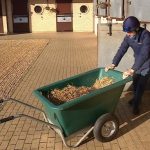Day One of your Racing Life
So… here we are! It’s your first day in a racing yard and it is all a bit scary. Everyone seems to know what they are doing except you. It is early in the morning, barely light and yet everyone is already bustling around with wheelbarrows and tack, horses are being taken on or off the walker and the farrier is here taking shoes off and putting racing plates on.
This ‘racing game’ is a business not like any other and you are now moving into a professional job. No more bringing in horses from the field with ropes around their necks. These animals are the crème de la crème of the horse world – athletes, royalty, celebrities even. And here you are, new to it all.
Don’t worry, just remember everyone in this yard also had a first day, just like you.
So, go and find the Head Groom or the Assistant Trainer announce your arrival and they will be likely to introduce you to a mentor or workplace buddy who will look after you and help you get to know how the yard works.
But it’s early in the morning and they may first point you to a wheelbarrow and fork and may provide you with uniform (depending on the yard).
The tack room is where you will find your name ‘on the board’ where riders and horses are matched up per lot. Look for your name, where it says first lot that will be your first ride of the day. Find out where the horse’s stable is. Anything you are not sure of, be sure to ask. Yes, they are usually tied up after you put the bridle on. You will also be given a grooming kit of your own. The horse is given a brush over, mane and tail brushed through and generally made to look tidy. Ask if you are not sure of how to put an exercise sheet on or where the pad should go. Your buddy can help you, or just ask the person in the next door box.
Now the excitement builds up, the call for “jockeys” or “pull them out” is shouted and you will have to be ready, take your turn to bring your horse out of the box and wait for a leg up. No going to the mounting block here and definitely no “1 – 2 – 3 Hup!” The horse will be held for you and up you go.
All you need do next is watch what everyone is doing, listen to instructions and keep your distance from other horses. Fillies and colts are kept separated but your job as a rider is to keep your horse safe and most importantly, look out for your fellow riders to make sure they are safe too. It is all about teamwork in racing, especially on the gallops.
Sometime in the morning, the Secretary will ask you to come into the office. On this first day she or he will want you to sign a BHA (British Horse Racing Authority) registration form, and the Secretary will explain the form and the registration to you. They will also want to know some personal details such as your next of kin, contact numbers etc. You may be asked if you are on any medication or have any allergies. They are not being nosey, it is all information that may be necessary to ensure your health and safety whilst at work. This is a good time to ask any questions. On your first or second day, you will be given a Health and Safety Induction. Among other things, you will be shown the fire procedures and where the assembly points are, who the first aiders are and the management structure.
Morning stables will finish (dependent on the workload) anytime from 11.30am to 12.30pm. You have then finished work until the evening, so you will have time to nip to the shops, meet someone for lunch or just have a sleep until it is time to go back for evening stables. This usually last for up to two hours when horses will be brushed, and beds, waters and hays prepared for the night ahead. Don’t be surprised if you are not given the horses you have ridden to “do up”.
Most yards still allocate a set amount of horses to you to look after. As a newcomer, it is highly unlikely you will be given a star to take care of. You may have a two-year-old which could turn into a flying machine next year.
It is quite normal for you to see the Trainer and/or his Assistant come out and check round all the horses, looking for signs of heat in legs, or a horse that is off colour or gone off in his coat.
Evening Stables finishes when all the horses are fed and tucked up for the night. Have an early night and then be fresh and ready for the next day ahead and in no time, you will have become part of a great team, working in a great job.

